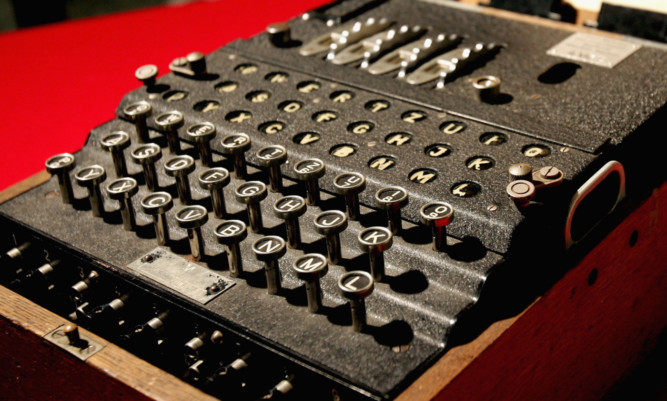From the outside it looks like an over-sized typewriter.
And yet the cracking of the famous Engima machines, which straddled the world of mechanical and electrical technology in the 1940s, is believed to have helped shorten the Second World War by around two years undoubtedly saving millions of lives in the process.
The Enigma machines were used by the Nazis to encode secret radio messages during the Second World War.
Messages were encrypted to prevent their adversaries from reading the content of their communications.
The machines were portable, easy to use and could be set up in a myriad of different ways, meaning it was almost impossible for a human to crack the code.
However, the mathematician Alan Turingwhose work was brought to life in the recent film ‘The Imitation Game’ starring Benedict Cumberbatchbuilt a machine that was able to do this and helped bring an end to the Second World War.
This built on the invaluable code-cracking work that had been carried out by the Poles since 1932 after they feared a German invasion to reclaim lands, post-Treaty of Versailles.
In 2013, Second World War military intelligence expert Dr Mark Baldwin was approached by the makers of The Imitation Game to supply a rare four-rotor U-boat Enigma machine.
Now Dr Baldwin is to bring the actual Enigma machine that was used in the film to a talk at Abertay University in Dundee where he will demonstrate how the code was generated and highlight the vital role of the codebreakers at Bletchley Park to break the potential 159 million million million encryptions
Having spoken on Enigma for nearly 20 years, the Cambridge University graduate, who has published eight books on the subject, said it was not difficult to understand how Enigma workedbut breaking the codes was a far greater challenge.
He told The Courier: “Unfortunately there are no surviving service records for any Enigma machine. The one I will be bringing was made in 1944 for the German Navy and sent to Norway. It was built for a U-boat and sent up there to be used. But this one was likely left behind after the Germans withdrew.”
Codebreaking was key. But there was also an element of “over confidence” by the Germans in their machines, he said.
Whereas the Enigma machines were portable, the machine that helped crack them at Bletchley Park weighed three quarters of a tonne by comparison.
Dr Natalie Coull, lecturer in ethical hacking at Abertay University, said the codebreakers of the past were a precursor of today’s ethical hackers, whose goal is to circumvent a range of security defences to gain access to data or systems.
She said: “This’ll be a fascinating talk. Anyone who’s seen The Imitation Game will be familiar with the Enigma machines and their role in encrypting messages, but it’ll be something else to see one in real life.”
The free public event, organised by BCS The Chartered Institute for ITwill take place on Wednesday September 30 at 6pm in the Main Lecture Theatre, Abertay University. To book go to
https://events.bcs.org/book/1647/
